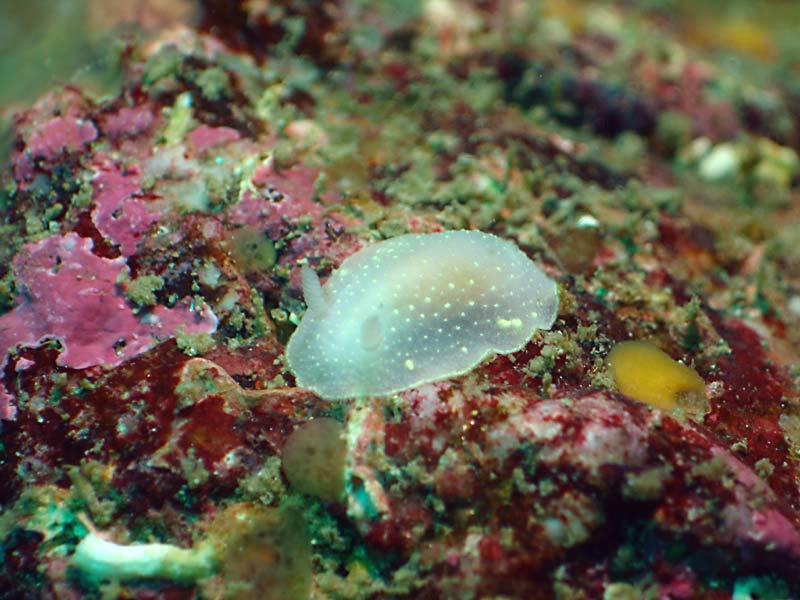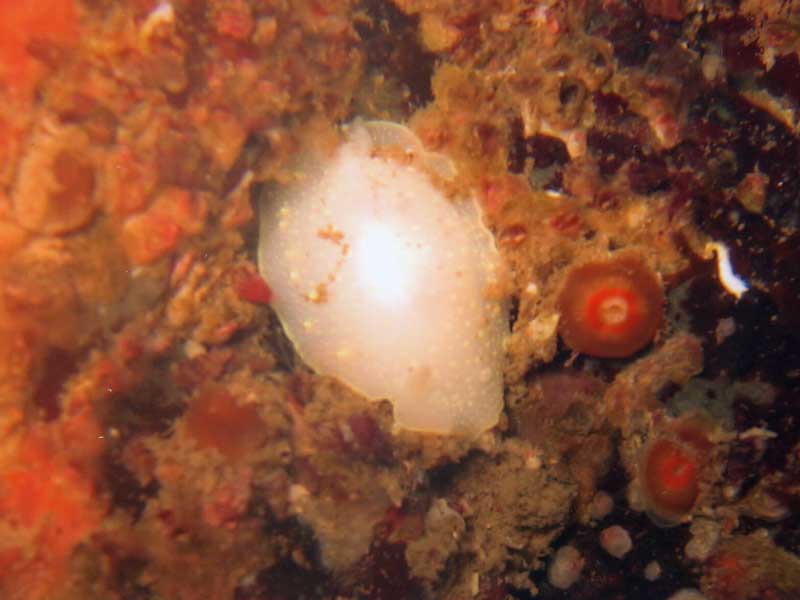White sea slug (Cadlina laevis)
Distribution data supplied by the Ocean Biodiversity Information System (OBIS). To interrogate UK data visit the NBN Atlas.Map Help
| Researched by | Sonia Rowley | Refereed by | Admin |
| Authority | (Linnaeus, 1767) | ||
| Other common names | White Atlantic cadlina | Synonyms | - |
Summary
Description
Cadlina laevis has a flattened, fragile oval body up to 3.2 cm in length. It is translucent white with opaque white or lemon-yellow pigmentation around the mantle edge. This species has distinctive white or lemon-yellow glands towards the mantle margin. The upper surface bears small conical, opaque white tubercules The underside is covered in a tracery of fine white markings. The front part of the foot (propodium) is groved to form two lips (bilaminate). Its white lamellate rhinophores are short and tapered, often with a yellow tip. The oral tentacles are short, broad and flattened. This species usually has 5 (rarely 6 or 7) tripinnate gills.
Recorded distribution in Britain and Ireland
This species is frequently recorded around most coasts of the British Isles.Global distribution
-Habitat
Cadlina laevis is common among Lithothamnion covered rocks from the shore to the sublittoral. It can be found primarily on its prey, the sponges Halisarca dujardini and Dysidea fragilis.Depth range
-Identifying features
- Flattened oval body up to 3.2 cm in length.
- Body, translucent white.
- Opaque white or lemon-yellow pigmented mantle edge and glands.
- Upper surface covered in small, conical, opaque tubercules.
- The rhinophores are lamellate often with a yellow tip.
- The oral tentacles are short, broad and flattened.
Additional information
Cadlina laevis was the first British nudibranch noted to reproduce by direct development (Thompson, 1967). Thompson (1967) observed that the embryonic period lasted for ca. 50 days with a vestigial veliger phase of 7 days occurring within the eggs. Tiny adults emerged from the eggs and remained benthic, having sufficient food reserves to sustain life and apparent growth for over a week before active feeding commenced (Thompson, 1967). Cadlina laevis feeds on encrusting sponges primarily Halisarca dujardiniand Dysidea fragilis. Interestingly, individuals of this species found in the north of the British Isles tend to have a milky white pigmentation and are mainly found in the littoral feeding on Halisarca dujardini. Individuals in the south and western parts of the British Isles have the distinctive lemon-yellow pigmentation and are mainly found feeding in the sublittoral on Dysidea fragilis (Picton & Morrow, 1994; Picton, 2001). It has been suggested that these two distinctive colour morphs may be separate species but the variation may be clinal due to its reproductive strategy (Picton & Morrow, 1994).
This species spawns in March and its penis is armed with numerous tiny hooked chitinous spines. The tripinnate gills of this species retract simultaneously into a common branchial pit, a process known as cryptobranchiate (Thompson, 1988).
Listed by
- none -
Bibliography
Costello, M.J., Bouchet, P., Boxshall, G., Emblow, C. & Vanden Berghe, E., 2004. European Register of Marine Species [On-line]. http://www.marbef.org/data/erms.php,
Foster-Smith, J. (ed.), 2000. The marine fauna and flora of the Cullercoats District. Marine species records for the North East Coast of England. Sunderland: Penshaw Press, for the Dove Marine Laboratory, University of Newcastle upon Tyne.
Hayward, P.J. & Ryland, J.S. (ed.) 1995b. Handbook of the marine fauna of North-West Europe. Oxford: Oxford University Press.
Howson, C.M. & Picton, B.E., 1997. The species directory of the marine fauna and flora of the British Isles and surrounding seas. Belfast: Ulster Museum. [Ulster Museum publication, no. 276.]
MarLIN (Marine Life Information Network), 2005. SEArchable BEnthic Data (SEABED) Map [on-line]. Data Access Sub-programme, Marine Life Information Network for Britian and Ireland http://www.marlin.ac.uk,
Moen, F.E. & Svensen, E., 2004. Marine Fish & Invertebrates of Northern Europe. Southend-on-Sea: Aqua Press.
Picton, B. E. & Morrow, C.C., 1994. A Field Guide to the Nudibranchs of the British Isles. London: Immel Publishing Ltd.
Picton, B.E. & Costello, M.J., 1998. BioMar biotope viewer: a guide to marine habitats, fauna and flora of Britain and Ireland. [CD-ROM] Environmental Sciences Unit, Trinity College, Dublin.
Picton, B.E., 2001. Cadlina laevis [on-line]. http://www.seaslugforum.net/, 2007-02-15
Seaward, D.R., 1990. Distribution of marine molluscs of north west Europe. Peterborough: Nature Conservancy Council.
Thompson, T.E., 1967. Direct development in a nudibranch, Cadlina laevis, with a discussion of developmental processes in Opisthobranchia. Journal of the Marine Biological Association of the United Kingdom, 47(1), 1-22.
Thompson, T.E., 1988. Molluscs: Benthic Opisthobranchs. London: Bath Press. [Synopses of the British Fauna New Series), (ed. Doris M. Kermack & R.S.K. Barnes), no. 8 (second Edition)].
Datasets
Centre for Environmental Data and Recording, 2018. Ulster Museum Marine Surveys of Northern Ireland Coastal Waters. Occurrence dataset https://www.nmni.com/CEDaR/CEDaR-Centre-for-Environmental-Data-and-Recording.aspx accessed via NBNAtlas.org on 2018-09-25.
Conchological Society of Great Britain & Ireland, 2018. Mollusc (marine) data for Great Britain and Ireland - restricted access. Occurrence dataset: https://doi.org/10.15468/4bsawx accessed via GBIF.org on 2018-09-25.
Conchological Society of Great Britain & Ireland, 2023. Mollusc (marine) records for Great Britain and Ireland. Occurrence dataset: https://doi.org/10.15468/aurwcz accessed via GBIF.org on 2024-09-27.
Fife Nature Records Centre, 2018. St Andrews BioBlitz 2016. Occurrence dataset: https://doi.org/10.15468/146yiz accessed via GBIF.org on 2018-09-27.
Manx Biological Recording Partnership, 2022. Isle of Man historical wildlife records 1990 to 1994. Occurrence dataset:https://doi.org/10.15468/aru16v accessed via GBIF.org on 2024-09-27.
NBN (National Biodiversity Network) Atlas. Available from: https://www.nbnatlas.org.
Norfolk Biodiversity Information Service, 2017. NBIS Records to December 2016. Occurrence dataset: https://doi.org/10.15468/jca5lo accessed via GBIF.org on 2018-10-01.
OBIS (Ocean Biodiversity Information System), 2025. Global map of species distribution using gridded data. Available from: Ocean Biogeographic Information System. www.iobis.org. Accessed: 2025-07-01
Citation
This review can be cited as:
Last Updated: 17/04/2008




